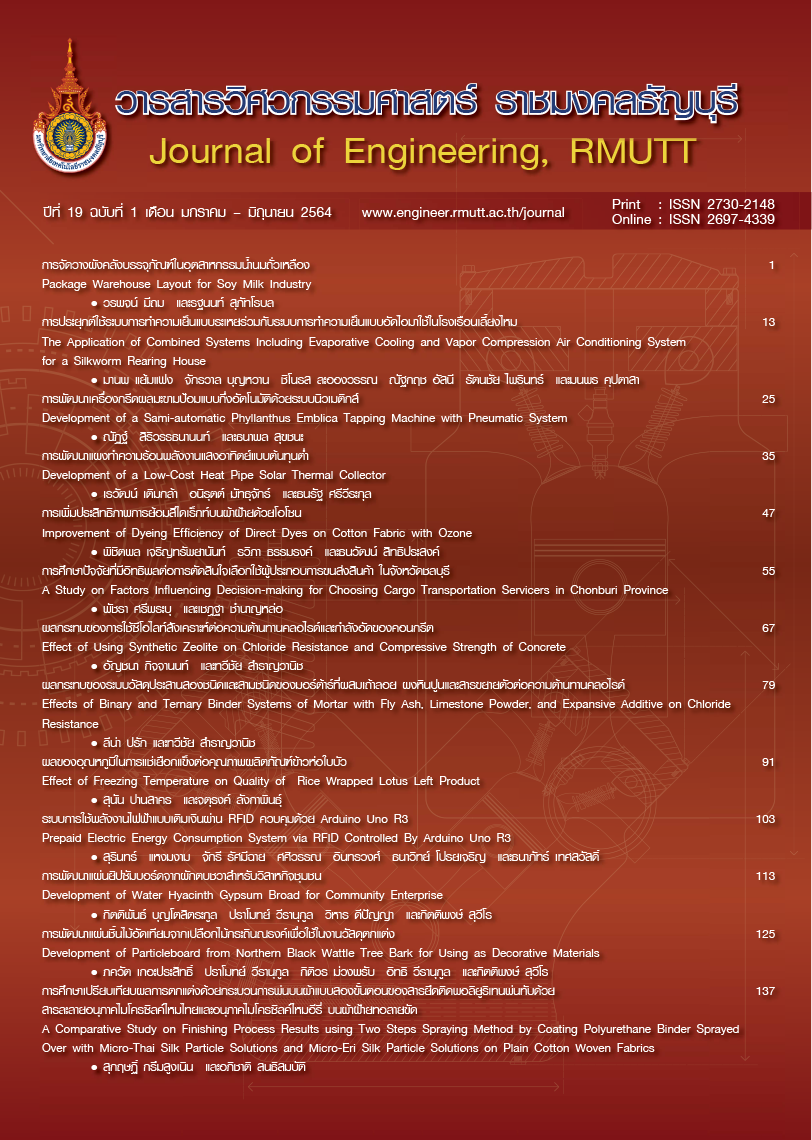Development of Particleboard from Northern Black Wattle Tree Bark for Using as Decorative Materials
Main Article Content
Abstract
This research aims to develop the particleboard from northern black wattle tree bark for using as decorative materials. The ratios of northern black wattle tree bark to polymeric diphenyl methane diisocyanate (pMDI) were designed into 12 ratios which differenced in pMDI amount (3% and 5%), density (450 and 700 kg/m3), and bark size (6 mm, 10 mm, and 6 and 10 mm). The developed particleboard samples were casted by using the compression 280 ksc and heat 150 oC for 7 minutes and tested by following the TIS.876-2004 standard. According to the results, the proper ratios of particleboard for decoration work were the particleboards which used the 700 kg/m3 of density, 7% of pMDI amount, and 10 mm or 6 and 10 mm of bark sizes. These particleboards had the properties which can meet the TIS.876-2004 standard including: density, moisture content, thickness swelling, tensile strength perpendicular to surface, and adhesive surface. However, some properties of particleboards cannot meet the standard including: bending strength, and elastic modulus. The developed particleboards had low thermal conductivity coefficient (0.120 - 0.131 w/m.K), especially when comparing to the other construction materials. Moreover, these developed particleboards can use as the decoration materials which can cut and drill as same as the particleboards in the market.
Article Details
The manuscript, information, content, picture and so forth which were published on Frontiers in engineering innovation research has been a copyright of this journal only. There is not allow anyone or any organize to duplicate all content or some document for unethical publication.
References
Yenjai P, Jarusombuti S, Veenin T. Particleboard manufacturing from waste of cajuput (Melaleuca cajuputi Powell). VRU Research and Development Journal Science and Technology. 2016;11(2):131-40. (in Thai)
Thai Industrial Standards Institute (TISI). Thai industrial standard no.876-2004: particleboard product. Bangkok: TISI; 2004. (in Thai)
American Society for Testing and Materials (ASTM). Standard test method for steady-state heat flux measurements and thermal transmission properties by means of the guarded-hot-plate apparatus (ASTM C177). Philadelphia: ASTM; 2010.
Cheng X, He X, Xie J, Quan P, Xu K, Li X, Cai Z. Effect of the particle geometry and adhesive mass percentage on the physical and mechanical properties of particleboard made from peanut hull. Bio Resources. 2016;11(3):7271-81.
Nemli G, Örs Y, Kalaycıoğlu H. The choosing of suitable decorative surface coating material types for interior end use applications of particleboard. Construction and Building Materials. 2005;19(4):307-12.
Bledzki AK, Gassan J. Composites reinforced with cellulose based fibers. Progress in Polymer Science. 1999;24(2):221-74.
Lin CJS, Hiziroglu SMK, Lai HW. Manufacturing particleboard panels from betel palm (Areca catechu Linn.). Journal of materials processing technology. 2008;197(1-3):445-8.
Sekaluvu L, Tumutegyereize P, Kiggundu N. Investigation of factors affecting the production and properties of maize cob-particleboards. Waste Biomass Valor. 2014; 5(1):27–32.
Weeranukul P, Suweero K, Weeranukul I. Coconut coir ceiling board product with thermal insulation property. Journal of Engineering, RMUTT. 2018;16(2):129-38. (in Thai)
Faherty KF, Williamson TG. Wood Engineering and Construction Handbook. New York: McGraw-Hill, Inc.; 1995.
Hazrat BM, Zarea HH, Daliri SM, Abginechi Z, Hemmati A. Mechanical and insulating performances of ultralight thick particleboard from sugarcane residues and woods planer shaving. Eur. J. Wood Prod. 2016;74(2):161–8.


